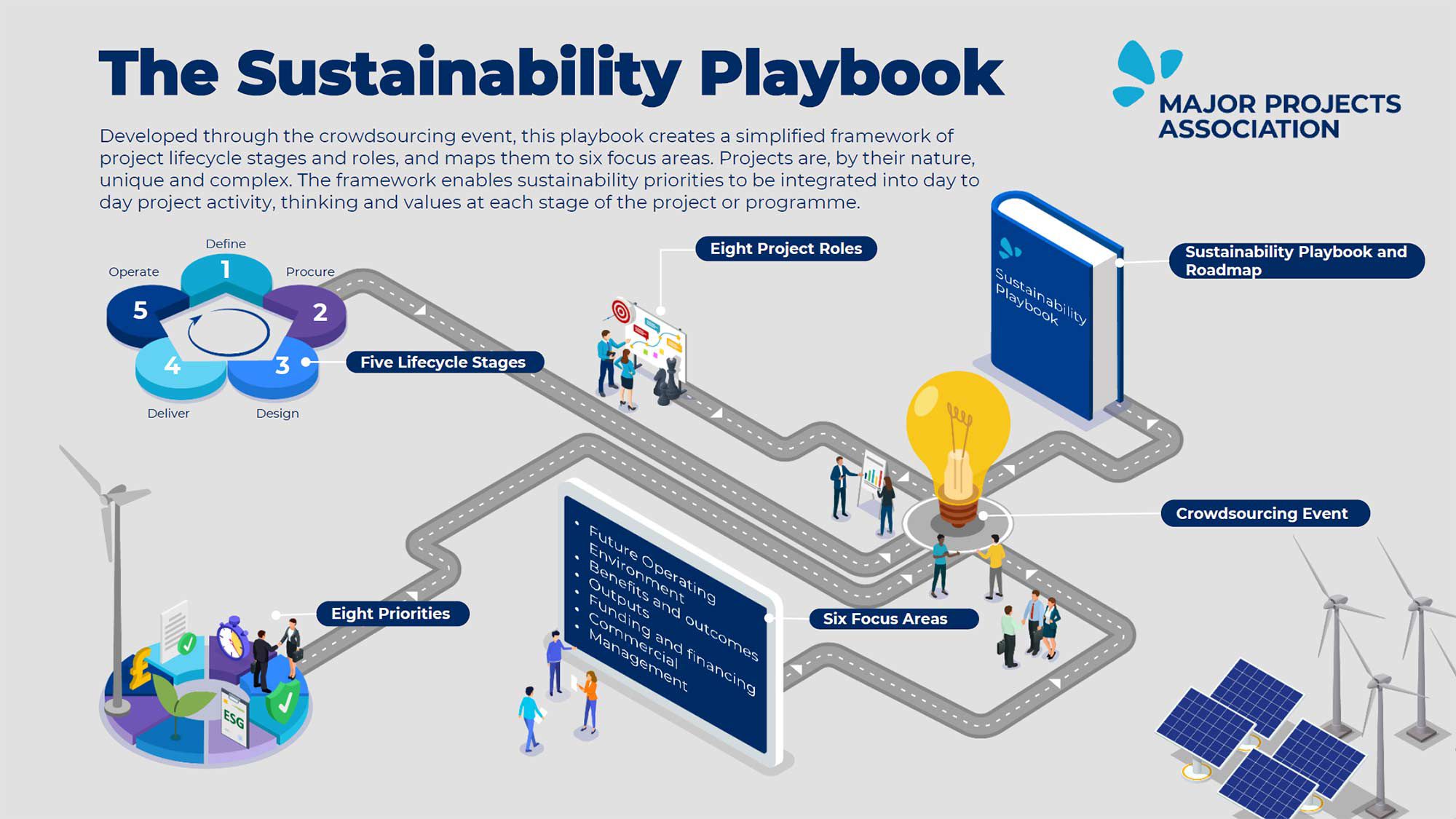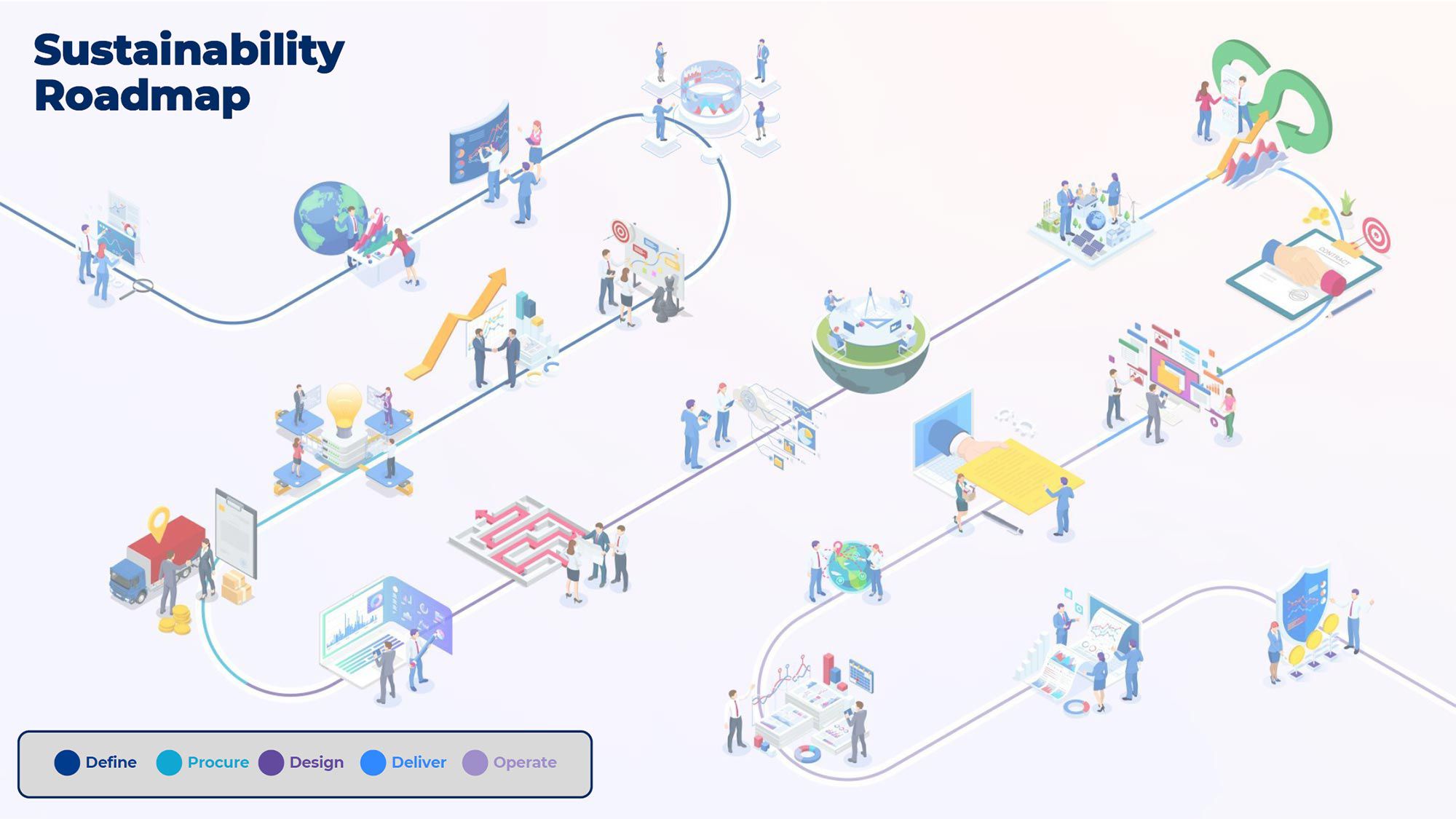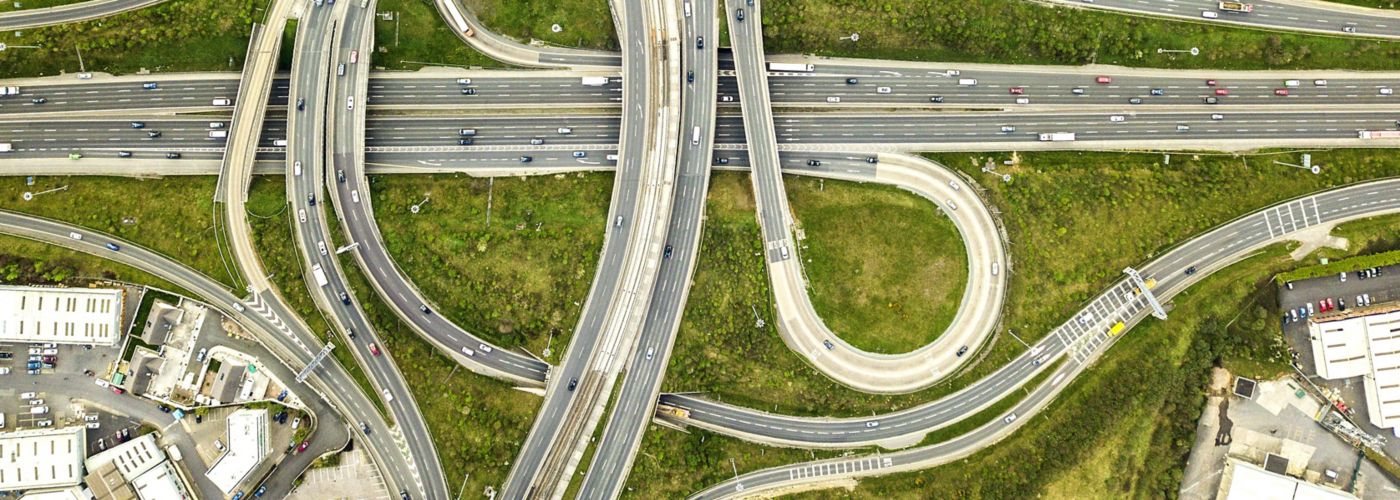Accounting for 79% of emissions globally and 88% of adaptation costs, the infrastructure sector is uniquely positioned, and singularly responsible for ensuring that sustainability is embedded into all aspects of projects, to support climate goals and resilience. With growing acceptance that there is no Plan and no Planet B, urgent action is required to build a sustainable future.
The Major Project Sustainability Playbook has been developed to respond to this requirement, offering an accessible and straightforward framework for integrating sustainability priorities into the infrastructure project lifecycle.
While the Playbook itself has been developed within the context of UK guidance and legislation, we have transposed elements of the Playbook below, to an Irish context, to capture the insights that will facilitate positive change in Ireland. We have used our national targets, regulations, and guidance to demonstrate how a similar approach can be applied to major projects in Ireland.
Developed to support project professionals in defining, procuring, designing, constructing, and operating sustainable projects, the Playbook emphasizes newer areas of the project lifecycle. These include biodiversity and nature, carbon and the environment, resilience and adaptation, and social value, that complement traditional considerations such as scope, cost, risk, and time.
This playbook was originally produced by the UK’s Major Projects Association in conjunction with KPMG UK.
Why do we need to act now?
The Playbook outlines how the four identified sustainability priorities are interwoven inextricably and for mutual benefit with the four “traditional” project priorities of scope, cost, risk and time.
As a result, the new approach allows for each of these priorities to be given equal weight within the project lifecycle. The framework starts by setting out the four identified action areas that should feature centrally in project planning and execution, and the underlying guidance/legislation that corroborates this assertion.
This has been reshaped to reflect an Irish perspective, highlighting the needs of a local context.

In 2021, the Climate Action and Low Carbon Development (Amendment) Bill set out the legislation that would place Ireland on a pathway to net-zero emissions by 2050, with an interim milestone of 51% reduction in emissions by 2030.
To support this objective, annual Climate Action Plans (CAP) are published to lay out the roadmap to achieving economy-wide decarbonisation within the required timeframe.
However, as of November 2024, Ireland is facing billions of Euro in fines for the projected failure to meet these targets. More must be done to meet this level of ambition; major projects must be approached from a new angle, focusing on sustainable design from inception.
Projects dedicated to climate adaptation or mitigation, or that actively seek to address the challenges associated with climate change and environmental degradation, should be prioritised.
Furthermore, they must be undertaken in a manner that incorporates the principles of circular economy, minimising raw material and energy consumption, pollution, and environmental impact.

Building resilience and adapting to a changed climate are required for protecting our infrastructure. In recent years, extreme weather events, in particular flooding and storms, have caused significant damage to infrastructure networks that are the lifeblood of the Irish economy and society.
Unprecedented winter flooding, and increased levels of summer flooding in 2023 alone are said to have caused several millions of euro of damage, and the Government has committed €1.3 billion to the delivery of flood relief schemes over the lifetime of the National Development Plan to 2030.
Designing new infrastructure for resilience will enable us to prevent or withstand the impacts of an increasingly unpredictable nature, and improvements to the existing network will support this goal. Studies have shown that investment in climate-resilient projects is also cost-effective.

Major projects can be a cause of pollution and decline in biodiversity, but also present an opportunity to be agents of positive change. With the correct design principles applied, major projects can protect and enhance biodiversity and climate resilience.
Ireland’s fourth Nature and Biodiversity Action Plan 2023-2024 propounds a whole-of-government, whole-of-society approach to biodiversity, focusing on conservation, net-gain and contributing to international initiatives.
The national Climate Change Advisory Council (CCAC) also promotes the use of nature-based solutions as means of “providing, maintaining or enhancing ecosystem services…to mitigate climate change, enhance resilience…and promote sustainable development”.
This reinforces the role that major projects can play, by exceeding the minimal standard of ‘do no significant harm’ and raising the benchmark to active conservation and strengthening.

Social value is intrinsic to sustainability, representing the S in ESG. It can be described as change within communities in support of an improved quality of life. The social impacts of major projects have long since been factored into infrastructure project assessments, with a focus on protecting the status quo and avoiding negative impact.
As with biodiversity and nature, it is now time for the sector to increase its ambition. With infrastructure supporting all aspects of social life, from housing to healthcare, education, transport, employment, leisure and recreation, its potential to create social value is by nature unassailable.
Social inequalities, the cost-of-living crisis, and recent inflation are factors that are driving a greater push for emphasis on social value in Ireland. In the context of climate, it is also clear that the distribution of the impacts of climate change, both in terms of frequency and intensity, is also unequal; we often see the greatest impacts in communities with the fewest means, reinforcing the need to focus on projects that will aim to minimise inequalities and improve quality of life.
What more can be done?
Assessing each of the four traditional project priorities individually is a useful mechanism for bringing sustainability into the project lifecycle. There are many ways in which each of these can be leveraged in support of greater sustainability outcomes.

The scope of a project refers to the specific work that needs to be completed to deliver the project’s objectives. This includes the project’s deliverables, features, functions and requirements.
As a project is being defined, and as early as possible, sustainability considerations need to be accounted. The scope of a project will ultimately be contingent on our assumptions of the asset’s future operational environment, which will doubtless look different from the one we are faced with today.
The case for incorporating sustainability requirements into future processes such as procurement, and investment decision-making, can all be defined at this early stage.

The cost of a project refers to the total money that will be spent to complete the project. This includes all direct and indirect costs such as labour, materials, equipment and overhead expenses.
The cost of major projects in Ireland is the subject of much scrutiny, and numerous recent controversies with respect to public expenditure have placed the cost of essential infrastructure under something of a microscope.
Implementing sustainability measures in major projects, for example taking a circular economy approach, can reduce the overall costs of a project over its lifecycle; designing for demolition allows what was previously construction waste to become a valuable raw material for future projects.

Risk refers to the possibility of an event occurring that could negatively impact the project’s objectives. This includes events that could delay the project, increase costs, or reduce the quality of the project’s deliverables.
We know that climate change poses significant risk to major projects, and will impact on how we design for the future. The pace of this change will dictate whether or not we are truly designing infrastructure that will be fit for purpose, or whether we are building future stranded assets.
When we talk about climate change, there is considerable risk in the do-nothing scenario.

The time of a project refers to the duration of the project, from its start date to its completion data. This includes the time required to complete all project activities, including planning, design, construction and testing.
Project duration in Ireland is another contentious issue, and the source of much commentary around the efficiency of processes that govern the delivery of major scheme. Operating efficiently and reducing the overall time of a project also has the potential to bring numerous sustainability benefits, as delays can impact on the adequacy of the design to the meet the needs of the scheme, when a lifespan is not fixed.
Equally, there is potential for reduced energy use, fewer emissions, and less waste and pollution when a project does not encounter excessive delay.
Conclusions
In the absence of a government department dedicated to infrastructure in Ireland, infrastructure itself will remain a cross-governmental function. As such, prioritisation of major projects involves a patchwork of many varied stakeholders acting within this ecosystem.
Under the new Programme for Government, we can be hopeful of transitioning this patchwork to a network, where coordinated efforts are supported by a fiscal framework for infrastructure spending, through the creation of an Infrastructure Division within the re-named Department of Public Expenditure, Infrastructure, Public Service Reform and Digitalisation.
How KPMG can help
As our clients navigate a new landscape, where designing major infrastructure for the future takes place in the absence of certainty over what that future will look like, support for embedding sustainable thinking and approaches is essential.
We can help to support design for a changed climate and balance the need for current investment with the benefits of building more adapted, equitable, and resilient infrastructure for the future.
Contact our team
Contact our team for experienced guidance on public and private sector projects today. We look forward to hearing from you.
Paul O'Neill
Co-Head of Infrastructure
KPMG in Ireland
Matthew King
Co-Head of Infrastructure
KPMG in Ireland
Neil Collins
Managing Director
KPMG in Ireland
Kieran Collins
Director
KPMG in Ireland
Orla O'Halloran
Associate Director
KPMG in Ireland




